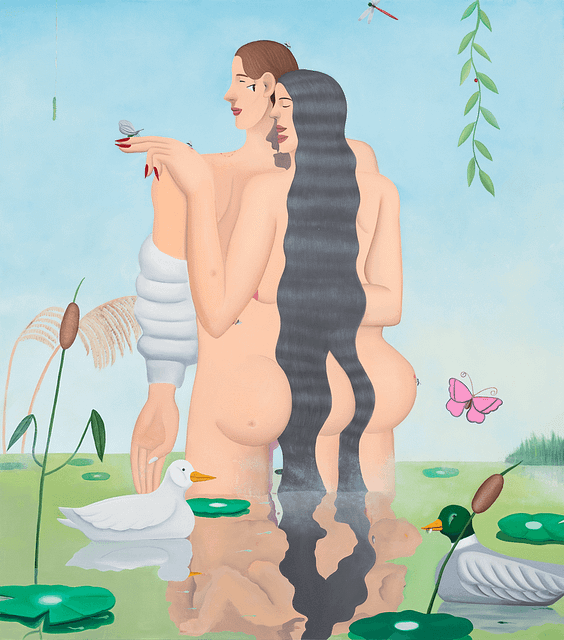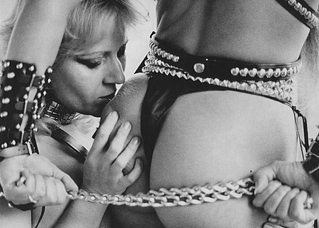
Para ler este artigo em português, clique aqui.
There’s a running joke in my friend group, made up mostly of gay men, that I’m like Mowgli: a straight girl raised in the queer community, who doesn’t know how to behave around other straight people. It’s something I like to boast about, as if it were an essential part of my identity. I want people to know that I’m not actually a straight woman, I’m a gay man. It wasn’t until last year that I discovered my behavior was part of a broader trend called “heteropessimism.”
The term was coined in 2019 by Asa Seresin, in the essay “On Heteropessimism,” published in The New Inquiry. Heteropessimism is the performative disidentification with heterosexuality, expressed in the form of embarrassment or sarcasm. It’s no coincidence the easiest place to find examples of heteropessimism is on social media, particularly Twitter, a playground for self-deprecating humor. I remember reading a post that declared, “It’s OK to be straight, the problem is behaving straight.”
Seresin argues that while heteropessimism has the potential to revolutionize heterosexuality, so far, it has largely functioned as an anesthetizing force, stalling any significant change. This is, I believe, because heteropessimists find themselves in a frustrated love-hate relationship with the objects of their affections.
Statistics on sexual and domestic violence against women are frightening, and living with the awareness of these numbers is uncomfortable. You’d have to be a bit oblivious to get involved with men, a luxury in our information society.
Some of my girlfriends’ behavior seems symptomatic of this kind of turmoil. On the one hand, they spout trendy feminist mantras, voice their contempt ad nauseam for the patriarchy — usually on social media. Meanwhile they spend a huge amount of time thinking about men in the most conventional ways possible, changing both their appearance and behavior to please them. And they suffer for it, waiting for their Prince Charming, a miraculous exception in this sea of toxicity. When confronted with these contradictions, these women sigh in resignation: the patriarchy is just too strong to tame the need for male approval. As one rather perceptive friend of mine so viciously put it: they’re sexists with a subscription to feminist Netflix.
What’s the point of fighting for gender equality if the patriarchy is an immutable institution? This resignation is what makes heteropessimism a conservative force. You have to believe in the possibility of change for it to happen. According to historian Hanne Blank, who wrote the book Straight: The Surprisingly Short History of Heterosexuality, heterosexuality as a concept was only described as such in 1868, the year when the word was first recorded. Károly Mária Kertbeny, an Austro-Hungarian journalist, coined both the term heterosexual and homosexual to protest laws banning sodomy in Germany. In other words, until that time, the definition was limited to the sexual act, and not the participant. Nor did it signify a cultural identity.
If heterosexuality is a culture, and culture is mutable, that means there’s hope. Even today, the idea persists that straight culture is “natural,” whatever that means. The criteria Susan Sontag set out in “Notes on ‘Camp,’” however, like artifice and exaggeration, can be just as neatly applied to the straight world. Wedding receptions, baby showers, and bachelor parties are all good examples.
In 2020, Rosanna Mclaughlin coined the term “Straight Camp” in an online article for Frieze about the reality show Love Island. For Mclaughlin, the show presents an over-the-top, dystopian version of heteronormativity, where exaggeration and artifice are obvious, making fascinating viewing for a queer audience. Contestants devote several hours a day to maintaining all the signifiers of beauty and attractiveness, all while seeming to find sexual intercourse immoral, even embarrassing. You must be an object of desire, but never act according to your desire. In other words: be sexy, not sexual.
Love Island might be seen as unintentional satire, but traditional gender markers are still everywhere, even among people who are connected to new ways of living. Without that, it would be easier for women to adopt a truly feminist praxis. Heteropessimism loses almost all its strength outside heteronormative contexts. For now, we can’t abolish the heteropatriarchy, but we can find our own niches, islands, gaps. It’s not easy, but the air is pure there, and we can breathe.
Last year, at a college friend’s birthday party, in an apartment with a dozen adults and a handful of children, I spent a few minutes watching two guests flirt with each other against a wall.
“It’s so funny to watch straight people flirt, isn’t it?” commented my friend.
“Yeah… Am I that way too?!” I asked, slightly alarmed.
“Of course not, Clara. You’re the type of person who gives blow jobs in the bathroom.”
It’s a silly anecdote — I don’t think it represents anything revolutionary in 2022 — but it’s symptomatic. I’ve been moving outside the borders of heteronormativity for a decade: I hardly ever go on dates, I have a few long-term, but purely sexual relationships (always with honesty and respect, fundamental qualities in a fuck buddy). And above all, I don’t intend on getting married or having children.
Over the years, I’ve done a thing or two with girls, always very sporadically, maybe a little beyond what you might hear about in a Katy Perry song. I’m an avid reader of gender studies, so I know that while sexuality is fluid, it’s not a rational choice, either. Seresin even admits in their text that the kind of political lesbianism that was fashionable during the second-wave feminism of the seventies is now considered somewhat outmoded.
Ironically, my closeness with a community of gay men reaffirms my heterosexuality. Dick is, of course, a recurring subject (length, girth, shape). My sexual storytelling has become 100 percent phallocentric. I don’t talk about my sex life in the same amount of detail with my female friends, especially those from more traditional backgrounds. Enthusiasm for male genitalia goes against the dictates of classical femininity. It’s not polite.
There’s a bell hooks quote that has helped me understand the strange liminal space I occupy: “queer not as being about who you’re having sex with (that can be a dimension of it); but queer as being about the self that is at odds with everything around it and has to invent and create and find a place to speak and to thrive and to live.” So I think a practical way out of heteropessimism is to mimic some of the sexual and affective strategies of the queer community.
In Minimizing Marriage, the philosopher Elizabeth Brake coined the term amatonormativity to define the prioritization of monogamous, romantic relationships over other types of interpersonal relationships, like friendship. Amatonormativity is essentially heterosexual. In the queer community, the concept of a chosen family represents an alternative for those who were not only rejected by their parents but were also unable to establish a traditional nuclear family (the legalization of same-sex marriage is, after all, quite recent).
Amatonormativity is detrimental to a woman’s ability to practice sisterhood — which, while a popular term in the feminist lexicon, isn’t so common in real life. In the straight world, a single woman is looked down on, since a partner isn’t just the object of romantic love, it’s a status symbol. A single woman has her life scrutinized; people unceremoniously ask about her sex life. A married woman, on the other hand, has the right to privacy, which isn’t always as helpful as it seems: we don’t know if she has sex, if she doesn’t, if she’s treated with respect, if the household chores are delegated exclusively to her, if she’s abused, a victim of domestic violence. There’s a pact of silence among married women that generates isolation and, in turn, benefits the patriarchy.
So it makes sense that sisterhood gets sidelined every time a love triangle forms between two female friends and a man. Friendships are tossed aside because they don’t offer the same symbolic rewards as romance. We learn from the movies, especially those aimed at a female audience, that romance is what makes life worth living, with big emotions and memorable stories. In real life, the stigma goes beyond the occasional awkward social situation, as other types of relationships don’t receive the same legal protections as marriage. A single person is literally a second-class citizen.
In this way, true sisterhood will only be possible when we hierarchize different types of interpersonal relationships more horizontally. Theorist Eve Kosofsky Sedgwick proposes a new perspective on platonic relationships in her book, A Dialogue on Love, that I find pretty appealing: “Oh, right, I keep forgetting, for lots and lots of people in the world, the notion of ‘falling in love’ has (of all things) sexual connotations. No, that’s not what I think is happening. For me, what falling in love means is different. It’s a matter of suddenly, globally, ‘knowing’ that another person represents your only access to some vitally transmissible truth or radiantly heightened mode of perception, and that if you lose the thread of this intimacy, both your soul and your whole world might subsist forever in some desert-like state of ontological impoverishment.”
My relationships with straight men became appreciably more carefree and healthier after I realized that much of my emotional reserve lies with my friends, who are my family. It’s possible to find alternative models to redirect our emotional, romantic, and sexual demands.
Earlier this year, I wrote an article for Brazilian Marie Claire about women who use Grindr. I created a profile on the app, selected a full body photo, and stated that I was a cisgender, heterosexual woman. I was surprised at the huge number of messages I received from interested men — after all, bisexuals are also on the app. The girls I interviewed for the story were typically Gen Z, looking for casual sex without the bureaucracy of Tinder or Bumble.
It’s radical strategy that makes no sense for women who are less sex positive. I haven’t gotten used to this arrangement myself, and I’m not even on the traditional apps. For now, the sexual encounter is still very important to me, as I believe a rich connection can occur between two bodies, even if their souls don’t go on to develop a relationship. My straight friends who have also rejected heteronormative models have embraced vibrators as a solution to reach orgasm. We know we’re often better off resolving this issue on our own than with a man. It’s a great victory for any human being when we take pleasure in being alone.
I often miss being with myself. I’ll scrap Saturday night plans to stay in with just my thoughts. I’ll also go out to dinner alone at a fancy restaurant if I feel like eating a particular dish. My priority is to be wherever I want to be. Sometimes it’s great to have casual sex or dance until dawn. Other times, it’s not, and the moment I realize I don’t want to be somewhere, I go home, guilt-free.
Psychology Today recently published an article that discusses a study showing a sizeable increase in the number of single, lonely men as women became more demanding of their partners. The article also notes that men are typically happier and healthier when they’re involved with a partner, though they lack the emotional skills to make a long-term commitment. At the same time, women are becoming increasingly comfortable being alone. In the UK, single, childless women are the happiest subgroup of the English population, according to Paul Dolan of the London School of Economics.
I don’t believe in individual initiatives to combat structural inequality — I say this as someone who stopped recycling after I read about the Kardashian clan’s three-minute flights. From a macropolitical perspective, there’s no reason to be hopeful, given the major recent setbacks to women’s rights. I won’t be around long enough to witness gender equality in a society that renders heteropessimism obsolete. But we still have some agency over our personal politics. So, with a few palliative methods, it may at least be possible to break free from the inertia and resignation, to find islands where heteronormativity isn’t the dominating force, to strengthen a community with shared affective values, towards possible change.


